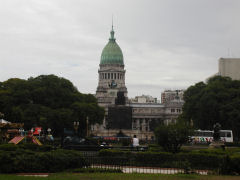 Buenos Aires – I had a couple of hours before my lunch date yesterday, and after running a few errands found myself near to the Plaza Congreso. The plaza has become home to daily gatherings of the unemployed and/or homeless – most just seem to choose a spot that is theirs for the day, some stay throughout the night, the fountain in the center varies between use as a bathing area for them and a play pool for local children. While certainly not the most rundown or dangerous of plazas in the city, except for weekends when an artesanal crafts fair takes over the park, it is one of the less savory.
Buenos Aires – I had a couple of hours before my lunch date yesterday, and after running a few errands found myself near to the Plaza Congreso. The plaza has become home to daily gatherings of the unemployed and/or homeless – most just seem to choose a spot that is theirs for the day, some stay throughout the night, the fountain in the center varies between use as a bathing area for them and a play pool for local children. While certainly not the most rundown or dangerous of plazas in the city, except for weekends when an artesanal crafts fair takes over the park, it is one of the less savory.
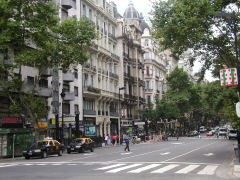 Stretching from the National Congress building to the Presidential Palace is the famed Avenida de Mayo, the city’s official processional route. I’ve travelled it by bus and taxi, purely by happenstance, and even walked the length once during the gay pride parade, though my attention wasn’t on the architecture that time. Back during the late 19th and early 20th Centuries, this was one of the main avenues to be completely rebuilt in a style that was intended to imitate the capitals of Europe, and especially Paris. Most of the buildings built at that time are still standing, and are a tribute to the French Beaux Arts architectural style.
Stretching from the National Congress building to the Presidential Palace is the famed Avenida de Mayo, the city’s official processional route. I’ve travelled it by bus and taxi, purely by happenstance, and even walked the length once during the gay pride parade, though my attention wasn’t on the architecture that time. Back during the late 19th and early 20th Centuries, this was one of the main avenues to be completely rebuilt in a style that was intended to imitate the capitals of Europe, and especially Paris. Most of the buildings built at that time are still standing, and are a tribute to the French Beaux Arts architectural style.
Beaux-Arts architecture depended on
sculptural decoration along conservative modern lines, employing French and Italian Baroque and Rococo formulas combined with an impressionistic finish and realism. Slightly overscaled details, bold scuptural supporting consoles, rich deep cornices, swags and sculptural enrichments in the most bravura finish the client could afford gave employment to several generations of architectural modellers and carvers of Italian and Central European backgrounds. – from the Wikipedia
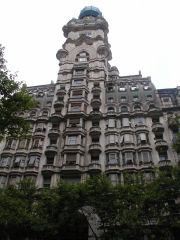 Possibly the most famous landmark building on the avenue is the Palacio Barolo, at #1370. Finished in 1923 for a rather wealthy textile merchant, Luis Barolo, and, at the equivalent height of 24 stories was the highest building in Buenos Aires at the time. The dome has a lighthouse with 300,000 small lights in it, most famously used for broadcasting the results of the Dempsey-Firpo fight to the residents along the coast of Uruguay, nearly 60 kilometers away! The Italian architect, Mario Palanti, had a thing for Dante’s Divine Comedy, and the building is filled with allusions to that work – a division into three parts of Hell, Purgatory, and Heaven, the dome containing representations of the nine angelic choirs, and the building having a height of 100 meters, to represent the 100 songs of the Comedy. The Salvo Palace, in Montevideo, Uruguay, is a twin to the Barolo.
Possibly the most famous landmark building on the avenue is the Palacio Barolo, at #1370. Finished in 1923 for a rather wealthy textile merchant, Luis Barolo, and, at the equivalent height of 24 stories was the highest building in Buenos Aires at the time. The dome has a lighthouse with 300,000 small lights in it, most famously used for broadcasting the results of the Dempsey-Firpo fight to the residents along the coast of Uruguay, nearly 60 kilometers away! The Italian architect, Mario Palanti, had a thing for Dante’s Divine Comedy, and the building is filled with allusions to that work – a division into three parts of Hell, Purgatory, and Heaven, the dome containing representations of the nine angelic choirs, and the building having a height of 100 meters, to represent the 100 songs of the Comedy. The Salvo Palace, in Montevideo, Uruguay, is a twin to the Barolo.
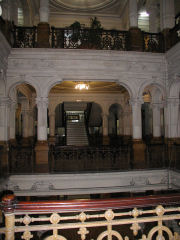
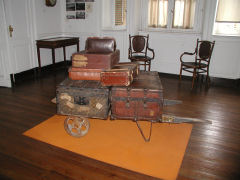
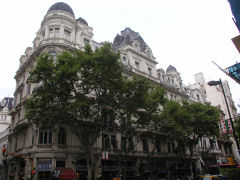 For those into social and government history, it’s a fascinating glimpse into that world. The building that the museum is in is the former Majestic Hotel, now home to the offices of AFIP.
For those into social and government history, it’s a fascinating glimpse into that world. The building that the museum is in is the former Majestic Hotel, now home to the offices of AFIP.
At 1199 is this interesting looking building. I wasn’t able to find out anything about it, but liked its look. Its major claim to fame, as such, is that on the ground floor it houses the Restaurante Plaza Asturias, one of the city’s most famous old-line Spanish restaurants, and somewhere I have yet to make it to. 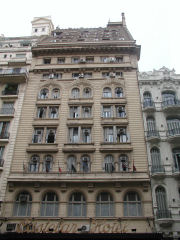 The 1100 block is the last block on the west end of the avenue, before crossing the 18-lane expanse of Av. 9 de Julio. One of the last interesting buildings is the Hotel Castelar, built by the same architect who built the Palacio Barolo, and originally called the Hotel Excelsior. Though the facade itself isn’t all that special, what I noted was way up at the roof line, where the sloped roof is dotted with several stories of windows – sort of attic hotel rooms. I continued on across the boulevard, and into the eastern section of Avenida de Mayo, where the architecture starts to trend a bit more modern – many buildings have been replaced during the last century, and there was also a slight turning towards the art nouveau style.
The 1100 block is the last block on the west end of the avenue, before crossing the 18-lane expanse of Av. 9 de Julio. One of the last interesting buildings is the Hotel Castelar, built by the same architect who built the Palacio Barolo, and originally called the Hotel Excelsior. Though the facade itself isn’t all that special, what I noted was way up at the roof line, where the sloped roof is dotted with several stories of windows – sort of attic hotel rooms. I continued on across the boulevard, and into the eastern section of Avenida de Mayo, where the architecture starts to trend a bit more modern – many buildings have been replaced during the last century, and there was also a slight turning towards the art nouveau style.
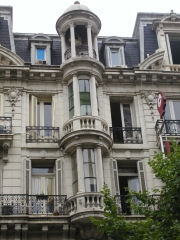
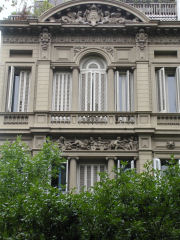
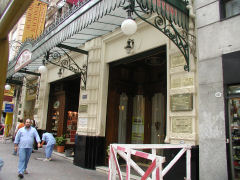 At 825 I came across the famed Café Tortoni, possibly the most historically well known café in Buenos Aires. It falls into one of those “must go” spots, that for one reason or another I haven’t. It really comes down to being an elegant coffee shop, but was, in its day, the gathering spot for some of Argentina’s most famous writers, artists, and actors. Leaning heavily towards the touristy end these days (and the main reason I haven’t bothered), it’s still a major piece of history (and therefore I ought to…).
At 825 I came across the famed Café Tortoni, possibly the most historically well known café in Buenos Aires. It falls into one of those “must go” spots, that for one reason or another I haven’t. It really comes down to being an elegant coffee shop, but was, in its day, the gathering spot for some of Argentina’s most famous writers, artists, and actors. Leaning heavily towards the touristy end these days (and the main reason I haven’t bothered), it’s still a major piece of history (and therefore I ought to…).
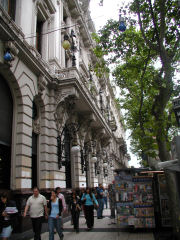
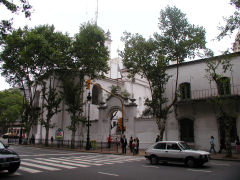
[…] A bit later I found myself in Plaza Congreso, and glancing up, happened to notice the old Confitería el Molino building, which I’d heard about but hadn’t noted before. It was named because it was erected on the site of the first flour mill in Buenos Aires (molino = windmill). The first “confectionary” was built in 1850, but later the building was torn down and completely rebuilt in 1917 in the art nouveau style. The new confitería continued to operate for another 80 years, and was “the” place for politicians and the elite of the city. In 1997 it closed its doors. […]
[…] Plaza Asturias, Avenida de Mayo 1199, is one of the top rated old-line Spanish restaurants in the city, by more than one rater. It’s also a semi-elegant (white tablecloths, nicely dressed waiters, good ambiance other than somewhat overly bright lights), very large (easily seating 150 people) spot located in a beautiful corner Beaux Arts building. From outside you could be excused for thinking it’s nothing more than a fancified cafeteria, but you’d be mistaken. While a place like this may never garner rave reviews for its decor, creativity, and presentation, if you want some solid, home-style, family food from Spain, you won’t be disappointed here – but stick to the Spanish side of the menu, what we ate from it, and what others were eating, was being downed with gusto; where they stray into local cuisine, i.e., the parrilla menu, which is stuck in the back of the menu book and clearly there for the folks who just won’t eat anything else, you’d be better off avoiding. […]
[…] Aires – A new Peruvian restaurant has just opened in Buenos Aires, situated behind the Palacio Barolo. The place is called Chan Chan, Hipolito Yrigoyen 1390, after the ancient city located outside […]
[…] – It’s amazing how time flies. It’s been more than two years since I posted a little walking tour along Avenida de Mayo and mentioned some of the beautiful Beaux Arts style buildings, including the […]
[…] side is primarily dominated by the back entrances to many important buildings along the parallel Av. de Mayo. The right hand side is a mix of office buildings and residences. I can’t say that there are […]